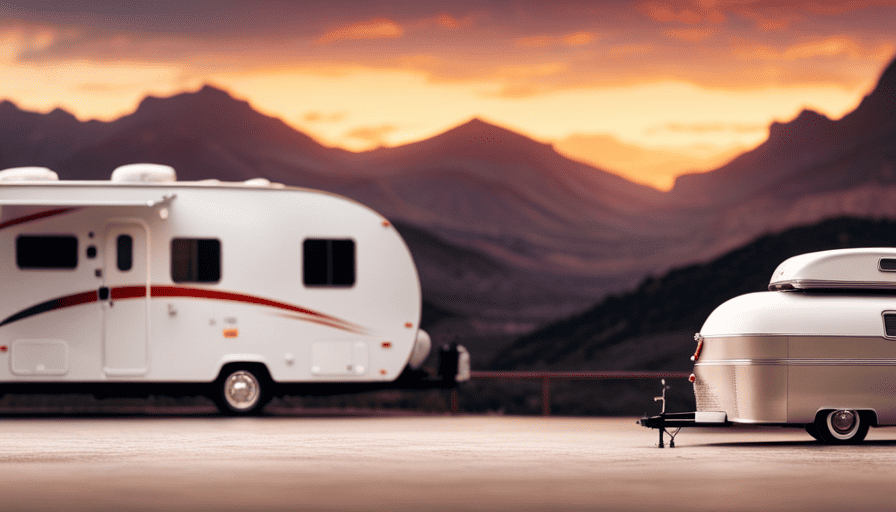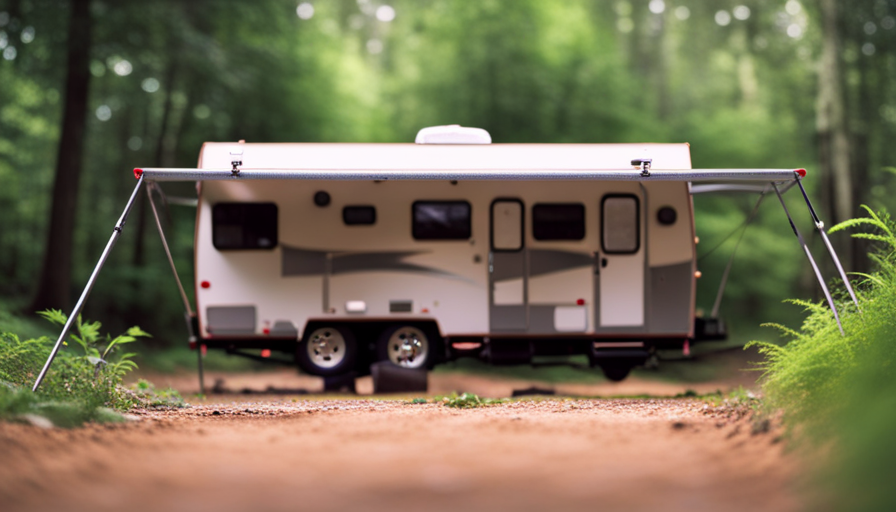Were you aware that the mass of a camper trailer can differ greatly based on its model and dimensions? Indeed! On average, a pop-up camper trailer tips the scales at approximately 1,200 to 2,700 pounds, whereas travel trailers can range in weight from 2,500 to 8,000 pounds.
Fifth-wheel trailers tend to be heavier, ranging from 12,000 to 15,000 pounds on average. And if you’re considering a teardrop trailer, you can expect it to weigh between 1,000 and 2,500 pounds.
Understanding the weight of a camper trailer is crucial for a safe and enjoyable adventure. It affects not only your vehicle’s towing capacity but also its stability on the road.
In this article, I will delve into the factors that contribute to the weight of a camper trailer and provide average weights for different types. I will also share tips on choosing the right weight for your vehicle and ensuring compliance with weight restrictions.
So, let’s get started and find the perfect camper trailer weight for your upcoming adventures!
Key Takeaways
- The weight of camper trailers varies depending on type and size, with pop-up camper trailers weighing between 1,200 to 2,700 pounds, travel trailers weighing between 2,500 to 8,000 pounds, fifth-wheel trailers weighing between 12,000 to 15,000 pounds, and teardrop trailers weighing between 1,000 to 2,500 pounds on average.
- Proper weight distribution is crucial for safe towing, with the majority of weight in pop-up camper trailers located towards the front and the tongue weight typically being 10 to 15% of the total weight. Fifth-wheel trailers have better weight distribution and stability while towing.
- The weight of a camper trailer affects the vehicle’s towing capacity, stability on the road, and fuel efficiency. Exceeding the towing capacity strains the vehicle’s engine, brakes, and suspension, while improper weight distribution can cause handling problems.
- When selecting a camper trailer weight, it is important to consider the vehicle’s towing capacity, the weight of the trailer and additional cargo or equipment, and to pack efficiently by prioritizing essentials and avoiding unnecessary items. Staying within recommended weight limits ensures a safer and more enjoyable camping experience and saves on fuel costs.
Understanding the Importance of Camper Trailer Weight
You need to understand the importance of camper trailer weight if you want to avoid potential dangers and ensure a smooth and worry-free journey.
The weight distribution of a camper trailer plays a crucial role in its overall performance and safety on the road. When towing a camper trailer, it is essential to know the weight capacity of your vehicle and how the weight of the trailer can impact it. Exceeding the towing capacity can put excessive strain on your vehicle’s engine, brakes, and suspension, leading to mechanical issues and decreased control while driving.
On the other hand, if the weight is not adequately distributed within the trailer, it can cause handling problems, such as swaying or fishtailing, which can be dangerous. Understanding the impact of weight on towing capacity is vital to ensure your safety and the safety of others on the road.
Moving on to factors that contribute to the weight of a camper trailer, let’s explore how these aspects affect the overall weight and towing experience.
Factors that Contribute to the Weight of a Camper Trailer
When considering the weight of a camper trailer, there are several factors that contribute to its overall heaviness.
One important factor is the size and length of the trailer, as larger trailers tend to be heavier.
Additionally, the construction material used in the trailer’s frame and body can greatly impact its weight, with materials like aluminum being lighter than steel.
Finally, the features and amenities included in the trailer, such as appliances and furnishings, can also add to its overall weight.
Size and Length of the Trailer
Camper trailers come in various sizes and lengths, making it important to consider their weight before embarking on your next adventure. The size of a camper trailer refers to its overall dimensions, including width, height, and interior space. Generally, larger camper trailers tend to weigh more due to the additional materials needed to construct them.
Trailer length is another factor that influences the weight of a camper trailer. Longer trailers often weigh more because they require more structural support and have more living space.
When choosing a camper trailer, it’s crucial to find the right balance between size, length, and weight to ensure that it can be safely towed by your vehicle.
Now, let’s explore how the construction material of a camper trailer affects its weight.
Construction Material
The type of material used in constructing a camper trailer significantly impacts its weight. When it comes to camper trailers, there are generally two main construction materials: fiberglass and aluminum.
Fiberglass trailers are known for their durability and lightweight nature. They’re constructed using molded fiberglass shells, which are then reinforced with other materials to provide strength. This construction method results in a camper trailer that’s lightweight, making it easier to tow and maneuver.
On the other hand, aluminum trailers are known for their strength and longevity. They’re constructed using aluminum sheets that are riveted together, creating a solid structure. While aluminum trailers tend to be heavier than fiberglass trailers, they offer better camper trailer weight distribution, which can have a positive impact on fuel efficiency.
Considering the construction material is essential when choosing a camper trailer, as it not only affects the weight but also the overall performance and fuel efficiency.
Moving forward, let’s explore the various features and amenities that can enhance your camping experience.
Features and Amenities
Imagine all the amazing features and amenities you could enjoy while camping in a camper trailer – can you picture yourself relaxing in a luxurious queen-sized bed under the stars? Camper trailers are designed to provide comfort and convenience while on the road. From fully equipped kitchens to spacious dining areas, these trailers offer everything you need for a home away from home experience. Let me paint a picture for you with a table that showcases some of the top features and amenities you can find in a camper trailer:
| Features | Amenities | Extras |
|---|---|---|
| Queen-sized bed | Fully equipped kitchen | Outdoor shower |
| Air conditioning | Bathroom with toilet | Electric awning |
| LED lighting | Dining area | Solar panels |
| Storage cabinets | Entertainment system | Bike rack |
| Wi-Fi connectivity | Slide-out rooms | Power generator |
With all these incredible features, it’s no wonder that camper trailers have become so popular among camping enthusiasts. Now, let’s move on to the next section and discuss the average weight of pop-up camper trailers.
Average Weight of Pop-Up Camper Trailers
Pack your bags and get ready for a lightweight adventure – the average weight of a pop-up camper trailer is around 1,000 to 2,000 pounds.
When it comes to camper trailer weight distribution, it’s important to know that the weight is not evenly distributed throughout the vehicle. The majority of the weight is located towards the front of the trailer, near the hitch, which helps with stability while towing. This means that the tongue weight, or the weight exerted on the hitch, is typically around 10 to 15% of the total weight of the trailer.
Considering weight limits for towing vehicles is crucial to ensure safe and efficient travel. Most mid-size SUVs and trucks can handle towing a pop-up camper trailer within this weight range. However, it’s always recommended to check the specific weight limits outlined by the manufacturer for your vehicle.
Now, let’s transition to the subsequent section about the average weight of travel trailers. These trailers are a step up from pop-up camper trailers in terms of size and weight.
Average Weight of Travel Trailers
Prepare yourself for a step up in size and weight as you delve into the world of travel trailers. These trailers are larger and heavier compared to pop-up camper trailers, offering more space and amenities for a comfortable camping experience.
Here are four key factors to consider when it comes to the average weight of travel trailers:
-
Size: Travel trailers come in various sizes, ranging from small teardrop trailers to large fifth-wheel trailers. The weight of a travel trailer increases proportionally with its size.
-
Construction: The materials used in the construction of travel trailers, such as steel or aluminum frames, affect their weight. Generally, trailers with steel frames tend to be heavier than those with aluminum frames.
-
Furnishings and Amenities: The weight of travel trailers can also be influenced by the furnishings and amenities they offer. Features such as kitchen appliances, bathrooms, and sleeping quarters can add significant weight to the trailer.
-
Weight Distribution: Proper weight distribution within a travel trailer is crucial for safe towing. Uneven weight distribution can lead to stability issues and affect fuel efficiency.
Considering the weight distribution and impact on fuel efficiency, it’s essential to choose a travel trailer that suits your towing capacity and vehicle capabilities.
Now, let’s move on to the next section, where we’ll discuss the average weight of fifth-wheel trailers.
Average Weight of Fifth-Wheel Trailers
Get ready to be amazed by the average weight of fifth-wheel trailers, as they offer a whole new level of spaciousness and luxury for your camping adventures.
Fifth-wheel trailers are known for their unique design, with a raised front section that extends over the bed of a pickup truck. This design allows for better weight distribution and stability while towing, making them a popular choice among camping enthusiasts.
When it comes to the weight of fifth-wheel trailers, it can vary depending on the size and features of the specific model. On average, fifth-wheel trailers can weigh between 12,000 to 18,000 pounds. However, some larger models can weigh up to 25,000 pounds or more. To ensure safe towing, it is important to have a properly rated tow vehicle and a weight distribution hitch.
A weight distribution hitch is a device that helps distribute the weight of the trailer evenly across the axles of the tow vehicle, improving stability and control while towing. It is an essential tool for towing fifth-wheel trailers, especially those on the heavier side.
Now that you know the average weight of fifth-wheel trailers and the importance of a weight distribution hitch, let’s move on to the next section about the average weight of toy hauler trailers.
Average Weight of Toy Hauler Trailers
The weight of toy hauler trailers can vary depending on their size, features, and the amount of cargo they’re designed to carry. On average, toy hauler trailers can weigh between 5,000 and 15,000 pounds.
However, it’s important to note that this is just an average range and individual toy haulers may weigh more or less than this. The weight of a toy hauler trailer can have a significant impact on fuel efficiency. Heavier trailers require more power to tow and can result in decreased gas mileage.
It’s important to consider the weight of your toy hauler when choosing a tow vehicle to ensure that it has enough power to handle the load. Additionally, a heavier trailer may require additional maintenance and may cause more wear and tear on your vehicle.
Overall, the weight of a toy hauler trailer is an important factor to consider when making a purchase decision.
Transitioning to the subsequent section about the average weight of teardrop trailers, it’s interesting to explore the differences between these two types of trailers.
Average Weight of Teardrop Trailers
Symbolizing the epitome of compact travel, teardrop trailers typically tip the scales at a mere 1,000 to 2,000 pounds on average. These lightweight trailers are crafted with precision and care during the teardrop trailer manufacturing process to ensure they remain light and easy to tow.
The benefits of owning a lightweight teardrop trailer are numerous. Firstly, their reduced weight makes them more fuel-efficient, allowing you to embark on longer journeys without worrying about excessive gas consumption. Secondly, their compact size enables them to be easily maneuvered into tight camping spaces or parked in your driveway when not in use. Additionally, their light weight means they can be towed by a wider range of vehicles, making them accessible to a larger demographic of outdoor enthusiasts. Lastly, the reduced weight translates to lower maintenance costs over time, as the wear and tear on your towing vehicle will be minimized.
Considering these advantages, it’s important to choose the right camper trailer weight for your vehicle to ensure a safe and enjoyable towing experience.
Tips for Choosing the Right Camper Trailer Weight for Your Vehicle
When it comes to selecting the perfect camper trailer weight for your vehicle, it’s crucial to consider these helpful tips for an enjoyable towing experience.
Choosing the right camper trailer weight is essential to ensure your vehicle can safely and effectively tow it. The first step in choosing the right weight is to check your vehicle’s towing capacity. This information can usually be found in your vehicle’s owner’s manual or by contacting the manufacturer.
Once you know your vehicle’s towing capacity, you can start looking for camper trailers within that weight range. It’s important to remember that the weight of the trailer should include not only the base weight but also any additional cargo or equipment you plan to bring along. This will help you accurately gauge if the trailer is within your vehicle’s towing capabilities.
Another factor to consider is the distribution of weight within the trailer. Ideally, the weight should be evenly distributed to ensure better stability and control while towing. Uneven weight distribution can cause swaying and make towing more difficult and dangerous.
Choosing the right camper trailer weight is crucial for a safe and enjoyable towing experience. By considering your vehicle’s towing capacity and ensuring proper weight distribution, you can find a camper trailer that is compatible with your vehicle. This will ensure safety and compliance with weight restrictions, which we will discuss in the next section.
Ensuring Safety and Compliance with Weight Restrictions
When it comes to choosing the right camper trailer weight for your vehicle, ensuring safety and compliance with weight restrictions is of utmost importance. As an experienced camper, I know that proper weight distribution is crucial for a smooth and controlled towing experience.
To ensure proper weight distribution, there are a few key steps to follow. First, it’s essential to check your vehicle’s towing capacity. This information can usually be found in the owner’s manual or by consulting the manufacturer. Knowing your vehicle’s towing capacity will help you determine the maximum weight you can safely tow.
Next, you should consider the weight of the camper trailer itself. This includes not only the dry weight but also any additional cargo, water, or propane tanks that may be added. It’s important to factor in these extra weights to ensure you stay within your vehicle’s towing capacity.
Additionally, you should pay attention to the weight distribution within the camper trailer. Properly distributing the weight will help maintain stability and control while towing. Make sure that heavy items are stored low and centered, and that the weight is evenly distributed between the axles.
Finding the perfect camper trailer weight for your adventures requires careful consideration of your vehicle’s towing capacity and ensuring proper weight distribution. By following these guidelines, you can enjoy a safe and enjoyable camping experience.
Conclusion: Finding the Perfect Camper Trailer Weight for Your Adventures
So, how can you ensure a safe and enjoyable camping experience by finding the ideal weight for your adventures? It’s essential to consider a few factors when determining the perfect weight for your camper trailer.
First, let’s talk about packing efficiently. One of the best tips for packing efficiently is to prioritize the essentials and avoid unnecessary items. This not only helps reduce the weight of your trailer but also ensures you have enough space for everything you truly need. Additionally, organizing your belongings in storage containers and using space-saving techniques like vacuum-sealed bags can further optimize your packing.
Now, let’s discuss the impact of weight on fuel efficiency. The weight of your camper trailer plays a significant role in how much fuel your vehicle consumes. Generally, the heavier the trailer, the more fuel it will require to tow it. To maximize fuel efficiency, it’s crucial to stay within the recommended weight limits provided by the trailer manufacturer and your vehicle’s towing capacity. Exceeding these limits can strain your vehicle’s engine, transmission, and brakes, potentially leading to safety hazards and increased fuel consumption.
By following these tips for packing efficiently and being mindful of the weight’s impact on fuel efficiency, you can find the perfect camper trailer weight for your adventures. This will not only ensure a safer and more enjoyable camping experience but also help save on fuel costs and minimize the environmental impact of your travels. Happy camping!
Frequently Asked Questions
How much weight can my vehicle safely tow?
The weight capacity and towing capacity of a vehicle are important factors to consider when determining how much weight it can safely tow. These specifications vary depending on the make and model of the vehicle. By referring to the vehicle’s manufacturer guidelines or consulting a professional, you can determine the maximum weight your vehicle can tow.
It’s crucial to never exceed the weight capacity or towing capacity as it can lead to safety hazards on the road.
Are there any weight restrictions for camper trailers in certain states or countries?
Weight restrictions and camper trailer regulations vary from state to state and country to country. It’s essential to check the specific regulations of the area where you plan to travel.
Some states or countries may have maximum weight limits for camper trailers, while others may require special permits or licenses for trailers over a certain weight.
It’s important to research and comply with these regulations to ensure safe and legal towing of your camper trailer.
What are the consequences of exceeding the recommended weight limit for a camper trailer?
Exceeding the recommended weight limit for a camper trailer can lead to serious consequences. Firstly, overloading puts excessive strain on the vehicle, resulting in decreased fuel efficiency and potential damage to the engine, transmission, and braking system.
Moreover, it greatly affects vehicle performance, making it more difficult to accelerate, brake, and maneuver safely. Additionally, it can cause tire blowouts and instability, posing a significant safety risk for both the driver and others on the road.
How does the weight of a camper trailer affect its fuel efficiency?
When it comes to fuel efficiency, the weight of a camper trailer plays a crucial role. Did you know that for every 100 pounds of additional weight, your fuel efficiency can decrease by 1-2%?
The impact on stability is significant, as a heavier trailer can be more prone to swaying on the road. Moreover, the increased weight also affects the braking distance, requiring more time and distance to stop safely.
Therefore, it’s important to consider the weight of your camper trailer for optimal fuel efficiency and safety.
Are there any specific regulations or guidelines for distributing weight within a camper trailer?
Yes, there are specific regulations and guidelines for distributing weight within a camper trailer. These regulations ensure safety and optimal performance while towing. It’s important to follow the manufacturer’s guidelines to avoid overloading the trailer.
Distributing weight evenly from front to back and side to side helps maintain stability and control while on the road. Additionally, it’s crucial to secure the load properly to prevent shifting during travel.
What is the Average Weight of a Fifth Wheel Camper Compared to a Camper Trailer?
When comparing fifth wheel camper weight information to camper trailers, the former generally weighs more. While camper trailer weights can vary greatly depending on size and features, fifth wheel campers often weigh significantly more due to their design and structure. It is important for prospective buyers to consider the towing capacity of their vehicle when choosing between the two options.
Conclusion
As I reflect on the importance of finding the perfect camper trailer weight for your adventures, I can’t help but be reminded of the delicate balance we seek in life.
Just as the weight of a camper trailer can either enhance or hinder our journeys, so too can the burdens we carry in our hearts.
By understanding the factors that contribute to camper trailer weight and ensuring compliance with weight restrictions, we can find harmony on the road.
May your travels be light and your heart be free as you embark on your next adventure. Safe travels, my friends.










